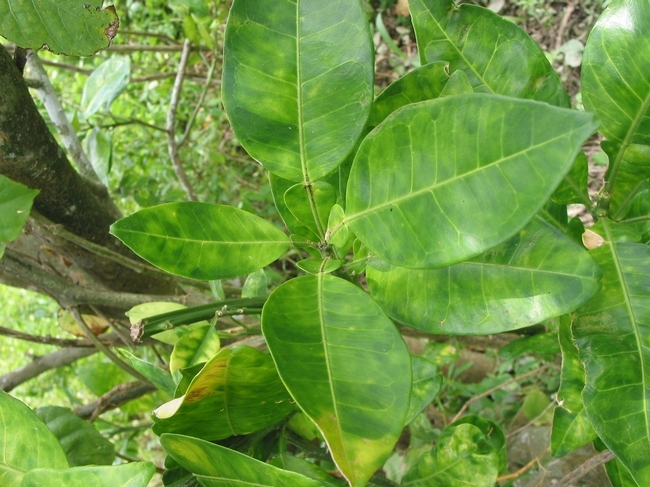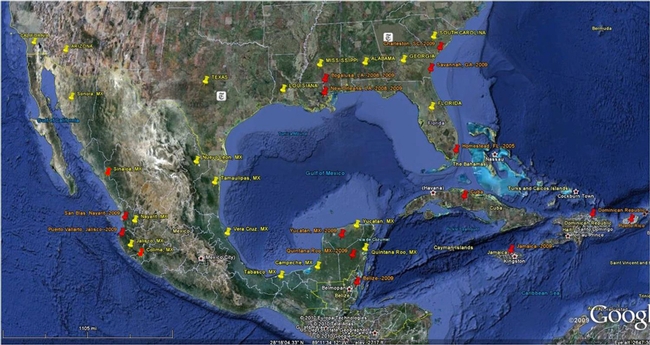
Posts Tagged: ACP
New Asian citrus psyllid website helps farmers and homeowners connect the dots
The early morning agriculture show on KMJ 580 in Fresno opened this morning with comments about UC's new Asian citrus psyllid website from Beth Grafton-Cardwell, UC Cooperative Extension specialist in the Department of Entomology at UC Riverside.
"There are a lot of websites out there relating to Asian citrus psyllid and huanglongbing disease," Grafton-Cardwell said. "What I tried to do in this one is give it a management focus with action steps: Here's where the bug and disease are, here's what you should do if you're a grower, here's what you should do if you're a homeowner. It connects the dots."
The story notes that the website includes a cost estimator for growers and homeowners that was developed by Karen Jetter, economist with the UC Agricultural Issues Center. The estimator lists effective pesticides and calculates the costs of application.
"It's a good way to figure out how you can help control Asian citrus psyllid," Grafton-Cardwell said.
The new website is at http://ucanr.edu/sites/acp.

The new Asian citrus psyllid website can be found at http://ucanr.edu/sites/acp.
Micronutrient deficiency can look like HLB infection

Neil O’Connell, UC Cooperative Extension advisor in Tulare County, a citrus expert, recommends that field staff also be well versed on these issues since they are in the field daily during the citrus harvest.
Huanglongbing, a disease spread by Asian citrus psyllid, is the worst citrus disease in the world. The disease was detected on one tree in Southern California in March, the first such find in the state. Officials are asking for farmers and home gardeners to be on the look-out for other HLB-infected trees.
O'Connell says deficiencies of zinc, iron and manganese can resemble leaf symptoms found in trees with HLB.
"Some deficiencies have fairly similar symptoms," O'Connell said. "If you are very familiar with deficiency patterns in these elements then it is much easier to separate this out. You can recognize whether the problem is zinc, iron, manganese, or another deficiency while possibly ruling out HLB."
A distinguishing characteristic of HLB infection is a yellow area that crosses from one interveinal area to another, O'Connell explained.
USDA to provide $11 million for citrus greening research
The USDA will provide $11 million for scientific research to battle citrus greening disease, according to a USDA news release issued this morning. Citrus greening disease is spread by the Asian citrus psyllid, which made its way to California in 2008. When a tree acquires the disease from the pest, nutrient flow is obstructed, the fruit stays green, grows lopsided and tastes bitter.
USDA will invest $2 million this year for research at the U.S. Horticultural Research Laboratory in Ft. Pierce, Fla. The remaining $9 million will be offered in a three-year competitive grants program by the agency's National Institute of Food and Agriculture.
The news release said USDA will also establish a Citrus Disease Research and Development Advisory Committee with representatives from the grower and scientific communities. The advisory committee, which reports to U.S. agriculture secretary Tom Vilsack, will provide leadership to citrus disease scientists.
Citrus greening is one of the most devastating diseases affecting any commercial agricultural crop, according to the National Academy of Sciences. More than 250,000 jobs representing key sectors of the U.S. economy are at risk, including harvesting, packaging, processing, transportation, marketing, retail sales, and nursery production.
Citrus greening threatens to destroy over 1 million commercial citrus acres that have an annual production value of approximately $3 billion across the nation. Yearly losses could reach $10 billion if citrus greening is left unchecked.
Asian citrus psyllid was first detected in California in San Diego and Imperial counties. The pest is believed to have been introduced from northern Mexico. Adult psyllids have also been trapped in Orange, Los Angeles and Ventura counties. The University of California, California Department of Food and Agriculture, USDA and the citrus industry are working closely to quarantine the affected areas and try to eradicate the pest.
The state of Florida first detected the Asian citrus psyllid in 1998 and citrus greening disease seven years later. The pest and disease have been detected in all 30 of Florida's citrus producing counties and in Louisiana, Georgia and South Carolina. The states of Texas, Mississippi and Alabama, like California, have detected the pest but not the disease.

Red pins on the Texas Department of Agriculture map show where citrus greening disease has been found. Yellow pins show where Asian citrus psyllid has been found.